Causes of death statistics by age group
Data extracted in March 2023.
Planned article update: 7 May 2024.
Highlights
In 2020, the standardised death rate from circulatory disease was higher for men than for women within the elderly population in all EU Member States.
The lowest standardised death rate from circulatory disease among elderly women in 2020 was reported in France and the highest in Bulgaria.
In the population aged less than 65 years, the highest standardised death rate from COVID-19 among the EU Member States in 2020 was reported for Bulgaria. The highest rates in the elderly population were in Belgium and Slovenia.
The standardised death rate from COVID-19 in 2020 was higher for elderly men than for elderly women in all EU Member States, with the largest relative difference in Malta.
Deaths from COVID-19 among people aged 65 years and over, 2020
This is an article using the most recent statistics on causes of death in the European Union (EU). It is important to identify and record the underlying reasons for deaths and make the information available to policymakers, health services and the public. With this data, it is possible to describe and understand the rate and trends in mortality. The data also serve to give information on changing epidemiological circumstances. Most causes of death vary significantly by age and by sex. This article gives an overview of the standardised death rates for the EU as a whole and for EU Member States with analyses by country of residence and age of the deceased. The use of standardised death rates facilitates comparisons both over time and between countries, independent of different population age structures.
This article is about the year 2020's data, most of which is being presented for the first time; this article includes data impacted by the COVID-19 pandemic and its related restrictions. For this reason, particular attention should be paid when comparing data with previous years.
Full article
Most frequent causes of death in the EU in 2020
The causes of death and their related death rates differ between age groups. The latest statistics related to causes of death for the European Union (EU) are available for the year 2020. In 2020, 84.9 % of all deaths of residents in the EU occurred among people aged 65 years and over (hereafter referred to as elderly people).
Just over one third (35.0 %) of all deaths in the elderly population in 2020 were caused by diseases of the circulatory system (see Table 1). Nearly one in three of these (or 11.0 % of all deaths) were caused by ischaemic heart disease. The second most frequent cause of death among elderly people was cancer, accounting for one fifth (20.5 %) of all deaths. The third most common cause of death in 2020 among elderly people was COVID-19, accounting for nearly one tenth (9.1 %) of deaths of elderly people.
Among residents in the EU aged less than 65 years, the first two leading causes of mortality were reversed. Cancer was the most frequent cause of death, accounting for one third (33.5 %) of deaths in this age group. Diseases of the circulatory system were the second most frequent cause of death (20.1 % of the total). These two common causes were followed at some distance by external causes with an 11.1 % share (of which more than half were accidents).
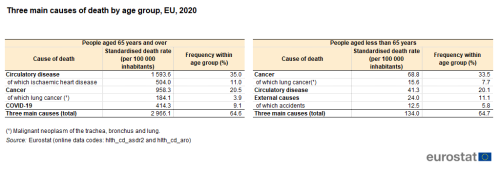
Source: Eurostat (hlth_cd_asdr2) and (hlth_cd_aro)
Analyses by sex and age of the most frequent causes of death in the EU in 2020
Circulatory disease was a more frequent cause of death among elderly women than among elderly men in the EU in 2020 (37.5 % and 32.1 % of all deaths, respectively) – see Figure 1. The reverse situation was observed for three other causes:
- cancer, accounting for 17.3 % of all deaths among elderly women and 24.1 % among elderly men;
- COVID-19, accounting for 8.2 % of all deaths among elderly women and 10.0 % among elderly men;
- respiratory disease [1], accounting for 6.3 % of all deaths among elderly women and 8.0 % among elderly men.
Among EU residents aged less than 65 years who died in 2020, cancer was the principal cause of death for more than two fifths (44.4 %) of females and more than one quarter (28.0 %) of males (see Figure 1). By contrast, circulatory diseases accounted for 15.2 % of all deaths among females aged less than 65 years compared with 22.5 % among males. Equally, the shares were lower among females aged less than 65 years than males for deaths from accidents: 3.3 % and 7.1 %, respectively. This was also the case in relation to deaths from COVID-19: 4.7 % of all deaths among females aged less than 65 years, compared with 5.4 % among males aged less than 65 years. As such, COVID-19 was, in 2020, a more common cause of deaths than accidents among females aged less than 65 years.
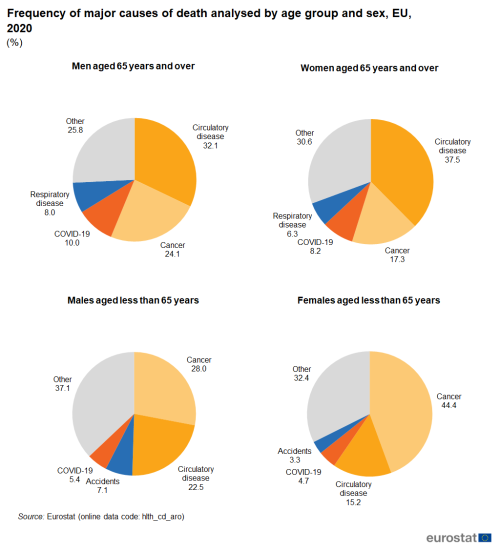
(%)
Source: Eurostat (hlth_cd_aro)
Standardised death rates – higher death rates among elderly people
Standardised death rates in 2020 were systematically higher among elderly residents in the EU than among younger residents; this pattern was observed for the overall death rate and for each of the main causes of death among elderly people. Figure 2 shows the major conditions causing death among elderly people and for each of these the standardised death rate is shown for the whole population and both age groups. COVID-19 was, by far the condition with the highest standardised death rate for the elderly population in 2020, with 414 deaths per 100 000 elderly inhabitants. Among people aged less than 65 years, this condition had the second highest rate, at 11 per 100 000 inhabitants aged less than 65 years. Lung cancer was the condition with the second highest standardised death rate for the elderly population, with 184 deaths per 100 000 elderly inhabitants. Among people aged less than 65 years, this condition had the highest rate, at 16 per 100 000 inhabitants aged less than 65 years.

(standardised death rate per 100 000 inhabitants in the age group)
Source: Eurostat (hlth_cd_asdr2)
Standardised death rates by country – circulatory disease
The standardised death rate from circulatory disease in 2020 was higher among elderly men than elderly women in all EU Member States (see Figure 3). The highest standardised death rates from circulatory disease among elderly men and elderly women were reported in Bulgaria, followed by Romania.
France was the only EU Member State to report a standardised death rate from circulatory disease among elderly men below 1 000 deaths per 100 000 male inhabitants in 2020, while rates below this level were reported for elderly females by seven Member States. In 2020, the lowest standardised death rates from circulatory disease within the elderly population were reported by France, 990 deaths per 100 000 male inhabitants and 622 deaths per 100 000 female inhabitants.
Among the European Free Trade Association (EFTA) countries, the highest standardised death rates from circulatory disease for elderly men and for elderly women were both reported by Iceland and the lowest rates both from Norway.
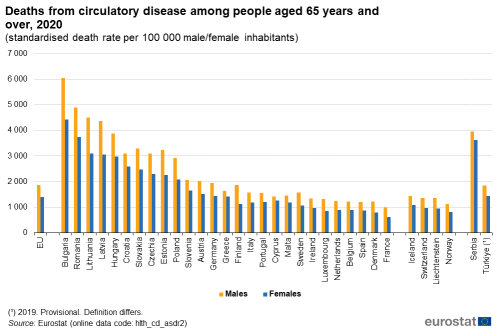
(standardised death rate per 100 000 male/female inhabitants)
Source: Eurostat (hlth_cd_asdr2)
Standardised death rates by country – COVID-19
In 2020, the highest standardised death rates from COVID-19 among the EU Member States were observed in Belgium and Slovenia (see Figure 4); these high overall rates reflected particularly high rates for elderly people, 872 and 794 per 100 000 people aged 65 years and over, respectively. The lowest standardised death rates from COVID-19 were observed in Estonia and Finland, which also had the lowest rates for elderly people, 67 and 43 per 100 000 people aged 65 years and over, respectively.
In all EU Member States, considerably higher standardised death rates from COVID-19 were observed in 2020 for elderly people than for people aged less than 65 years. In Slovenia, the standardised death rate for elderly people was 93 times as high as the equivalent rate for people aged less than 65 years, the highest such ratio among the Member States. For the EU as a whole, the rate for elderly people was 39 times as high as for the younger age group. The lowest ratio between the rates for these two age groups was observed in Bulgaria, with the rate for elderly people 11 times as high as for those aged less than 65 years.
Among the non-EU countries for which data are presented in Figure 4, Liechtenstein, Serbia and Switzerland recorded relatively high standardised death rates from COVID-19 in 2020 among their elderly populations, 657, 580 and 526 per 100 000 elderly inhabitants, respectively. The rates in Iceland and Norway were notably lower, at 61 and 41 per 100 000 elderly inhabitants, respectively. As such, the rate for elderly people in Norway was lower than in any of the EU Member States.
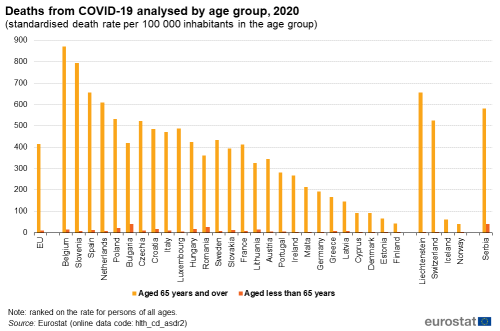
(standardised death rate per 100 000 inhabitants in the age group)
Source: Eurostat (hlth_cd_asdr2)
In the elderly population, the highest standardised death rates from COVID-19 in 2020 among the EU Member States were recorded for men in Belgium and Slovenia (see Figure 5). The same Member States also reported the highest standardised death rates from COVID-19 for elderly women. Equally, the lowest rates for elderly men and for elderly women were observed in Estonia and Finland. Among all elderly people (both sexes), the ratio between the standardised death rates in Belgium (the highest rates) and Finland (the lowest rates) was 20.2 : 1, with similar ratios for elderly men (20.5 : 1) and for elderly women (20.1 : 1). Among the non-EU countries for which data are shown in Figure 5, Norway recorded rates for each of the sexes that were slightly lower than those observed in Finland.
In all EU Member States, the standardised death rate from COVID-19 was higher in 2020 among elderly men than among elderly women. Nevertheless, the range in this ratio was quite narrow (compared with some other causes of death): the largest gender difference was in Malta, where the rate for elderly men was 2.7 times as high as that for elderly women, while the ratio was lowest (1.4 times as high) in Ireland.
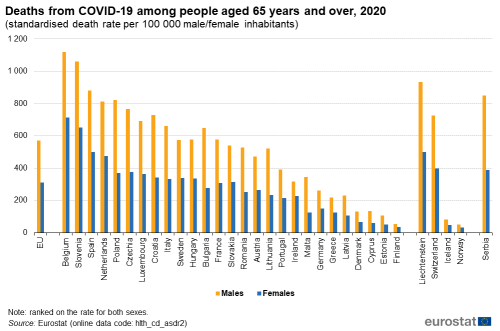
(standardised death rate per 100 000 male/female inhabitants)
Source: Eurostat (hlth_cd_asdr2)
Developments over time
Men aged 65 years and over
Between 2010 and 2020, the EU standardised death rate of cerebrovascular disease for elderly men decreased by more than one quarter (down 27 %) and that of ischaemic heart disease by more than one fifth (down 21 %) – see Figure 6. The death rates from lung and colorectal cancers decreased by 17 % and 15 %, respectively, while death rates from prostate cancer and from diseases of the respiratory system decreased by around one tenth (down 10 % and 9 %, respectively). As such, during the period under consideration the rates for all of these major causes of death declined among elderly men, most in a fairly regular manner but less so in the case of diseases of the respiratory system.
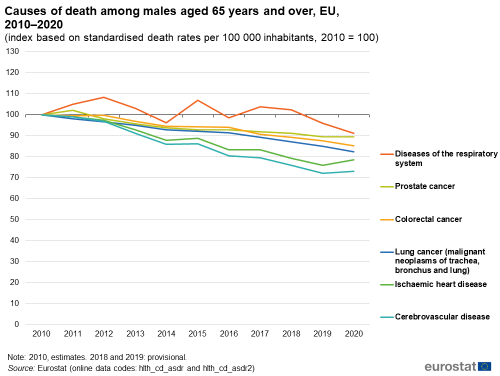
(index based on standardised death rates per 100 000 inhabitants, 2010 = 100)
Source: Eurostat (hlth_cd_asdr) and (hlth_cd_asdr2)
Women aged 65 years and over
In contrast to the situation observed for elderly men, the standardised death rate for lung cancer increased every year among elderly women and was 26 % higher in 2020 than it had been in 2010 (see Figure 7). The standardised death rates for the other major causes of death among elderly women declined during this period, but only marginally so for breast cancer and for diseases of the respiratory system (both down 2 % overall). As for elderly men, the development of the death rate for diseases of the respiratory system was more volatile than for the other major causes of death. The rate for colorectal cancer was down 15 % for elderly women, similar to the fall observed for elderly men. For ischaemic heart disease and for cerebrovascular disease, the rates for elderly women decreased by 21 % and 27 %, respectively, representing slightly smaller declines than observed for elderly men.

(index based on standardised death rates per 100 000 inhabitants, 2010 = 100)
Source: Eurostat (hlth_cd_asdr) and (hlth_cd_asdr2)
People aged less than 65 years
The EU standardised death rate for people aged less than 65 years fell by 12 % between 2010 and 2020 (see Table 2). Decreases of at least one fifth were noted for each of the three main causes of death. The standardised death rate for cancer fell 20 %, that for circulatory disease fell 23 % and that for accidents fell 27 %.
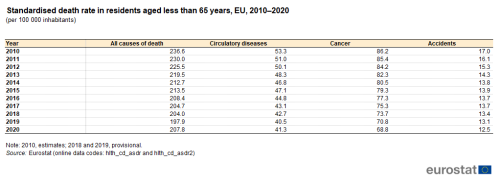
(per 100 000 inhabitants)
Source: Eurostat (hlth_cd_asdr) and (hlth_cd_asdr2)
Source data for tables and graphs
Data sources
Statistics on the underlying causes of death provide information on mortality patterns. This source is documented in more detail in this background article which provides information on the scope of the data, its legal basis, the methodology employed, as well as related concepts and definitions.
Legal basis for the data collection
Since reference year 2011, reporting countries have submitted data to Eurostat based on the requirements of Regulation (EC) No 1338/2008 [2] on Community statistics on public health and health and safety at work, and Regulation (EU) No 328/2011 [3] on Community statistics on public health and health and safety at work, as regards statistics on causes of death. For data before reference year 2011, countries submitted data to Eurostat based on a gentleman’s agreement established within the context of Eurostat’s Working Group on Public Health Statistics.
There are currently 33 countries submitting data on the causes of death to Eurostat:
- 27 EU Member States,
- EFTA countries (Iceland, Liechtenstein, Norway and Switzerland),
- candidate countries and potential candidates (Serbia and Turkey).
National and regional (NUTS level 2) data are collected.
Classification of the causes of death
Statistics on the causes of death are based on medical information provided in death certificates. Causes of death are classified by the 86 causes in the European shortlist which is based on the International Classification of Diseases and Related Health Problems. When the outbreak of COVID-19 started, the WHO introduced emergency codes in the ICD version 10 (ICD-10) that countries could use to report deaths from COVID-19. In Eurostat's dissemination database, the codes are available as follows:
- U071 – COVID-19, virus identified (deaths where COVID-19 has been confirmed by laboratory testing),
- U072 – COVID-19, virus not identified (COVID-19, virus not identified),
- U_COV19_OTH – COVID-19 other (COVID-19 death not elsewhere defined).
The data for COVID-19 reported in this article were calculated by adding the data for these three codes, however the data disseminated in Eurostat's dissemination database are for each separat code. More information about ICD-10 codes can be found here.
Standardised death rate
The number of deaths from a particular cause of death can be expressed relative to the size of the population. A standardised death rate is adjusted to a standard age distribution. This facilitates comparisons of rates over time and between countries. The European standard population used for the standardisation of crude rates is based on the European Standard Population (ESP) in use since summer 2013.
Context
Statistics on causes of death are among the oldest medical statistics available. They provide information on developments over time and differences between countries in causes of death. These statistics play a key role in the general information system relating to the state of health in the EU. They may be used to determine which preventive and medical-curative measures or which investments in research might increase the life expectancy of the population.
Statistics concerning causes of death among people aged 65 years and over (referred to in this article as elderly people) are of increasing interest. A dramatic change in the nature and delivery of healthcare over the past century has resulted in much longer life spans and a greater prevalence of chronic illnesses. This in turn has led to increased demand on healthcare systems, particularly for long-term care. Public health programmes throughout the EU are often targeted at reducing mortality among people aged less than 65 years through preventive measures, for example, the promotion of healthier lifestyles through improved nutrition, lower tobacco and alcohol consumption, an increase in physical activity or a reduction of workplace risk.
According to Eurostat 2019 baseline year projections, the share of the population aged 65 years and over in the EU is projected to increase relatively rapidly to 30.3 % of the total population by 2058 and then more slowly to 31.3 % by 2100; in 2022, the share was 21.1 %.
COVID-19 pandemic
The COVID-19 pandemic highlighted the need to prioritise public health, and strengthen healthcare systems across the EU and globally. In response to the pandemic, the European Commission took a series of actions to contain the spread of the coronavirus, support national health systems and counter the socio-economic impact of the pandemic, at both national and EU level.
This included:
- Supporting research and development in vaccines, and implementing a vaccine strategy.
- Launching the European Health Emergency preparedness and Response Authority (HERA), which aims to prevent, detect, and rapidly respond to health emergencies.
- Participating in COVAX, the world's facility for fair and universal access to COVID-19 vaccines.
- Laying the foundation for establishing a European Health Union, based on two pillars:
- A stronger health security framework, and
- More robust EU agencies.
You can read more about the Commission’s response to the COVID-19 pandemic here.
Direct access to
Online publications
Causes of death
Health status – selected diseases and related health problems
Specific health conditions
- Cardiovascular diseases statistics
- Cancer statistics
- Cancer statistics – specific cancers
- Respiratory diseases statistics
- Mental health and related issues statistics
- Accidents and injuries statistics
Methodology
General health statistics articles
- Health (t_hlth)
- Causes of death (t_hlth_cdeath)
- Health (hlth)
- Causes of death (hlth_cdeath)
- Causes of death statistics (ESMS metadata file – hlth_cdeath_sims)
- Revision of the European Standard Population – Report of Eurostat’s task force – 2013 edition
- European Commission – Directorate-General for Health and Food Safety – Non-communicable diseases
- European Commission – Directorate-General for Health and Food Safety – European Core Health Indicators (ECHI), Health Status indicators, Disease-specific mortality
- Joint OECD / European Commission report Health at a Glance: Europe
- WHO Global Health Observatory (GHO) – global health estimates: life expectancy and leading causes of death and disability
Notes
- ↑ Data on respiratory diseases do not include COVID-19.
- ↑ http://data.europa.eu/eli/reg/2008/1338/oj
- ↑ http://data.europa.eu/eli/reg/2011/328/oj